Winter Garden Insights 2023
By Brian Nixon, Horticultural Manager
A visit to The Gardens during the winter season is a must, and it is personally one of my favorite seasons. After the colourful annuals and spectacular perennials take a rest, you are left with the bones, and the structure that really defines The Gardens. Your eyes become drawn to the vast landscape, the fine details and the hard work that has gone into creating The Butchart Gardens. The overall design of the landscape is much more visible during the winter, starting with the meticulously designed flower beds followed by the well thought out placement of specimen trees. A visit during the winter season gives visitors a greater understanding of the vision that Jenny Butchart had in order to create this true masterpiece.
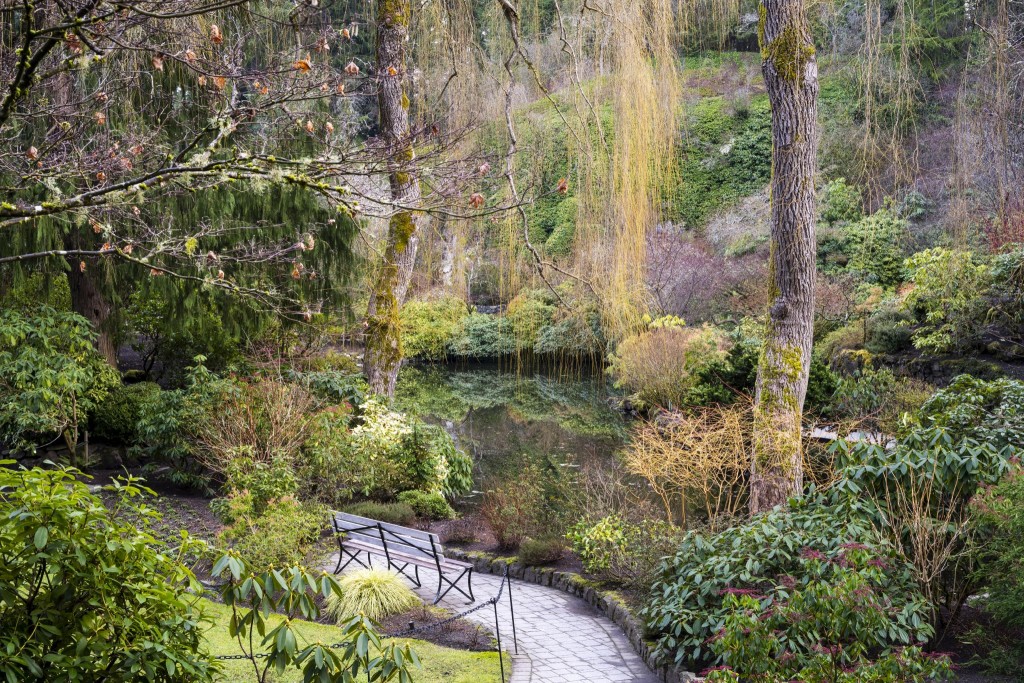 A quiet spot to stop and take in the winter garden
A quiet spot to stop and take in the winter garden
There is a sense of peace and tranquility which radiates through The Gardens in the winter season. Whether it’s the sound of water features and streams echoing through the landscape, or birds singing joyfully, these wonderful sounds compliment many of the plants which are now taking center stage throughout The Gardens. Some of the plants you see around The Garden don’t get a chance to showcase their true beauty until now. Interesting features to look for are bright colored and contorted branches, moss and lichen growing on trees along with winter flowering shrubs and early bulbs. There are also early signs of spring popping out all over the place.
Please refer to the bottom of this blog to view a comprehensive list of plants, trees and shrubs which are now captivating visitors, and receiving plenty of attention.
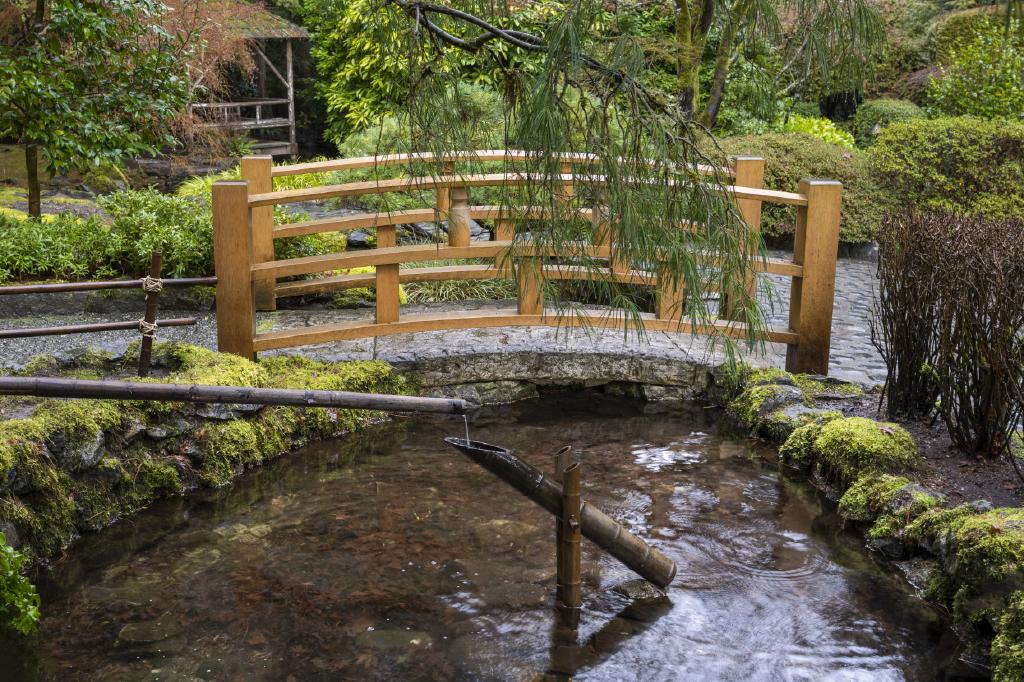 Soothing sounds of water features fill the Japanese Garden
Soothing sounds of water features fill the Japanese Garden
If the first week of winter was a clear indicator of what we should expect in the next 3 months, it could be a cold season with plenty of precipitation and snow. I don’t believe anyone could have predicted the wild weather we received during the first week of December here on the West Coast. The Gardens were covered with over one foot of snow during that time, which provided a beautiful setting for the Magic of Christmas. Thanks to a collective effort by all staff, we cleared the snow from parking lots and pathways allowing visitors to enjoy our snow-covered garden.
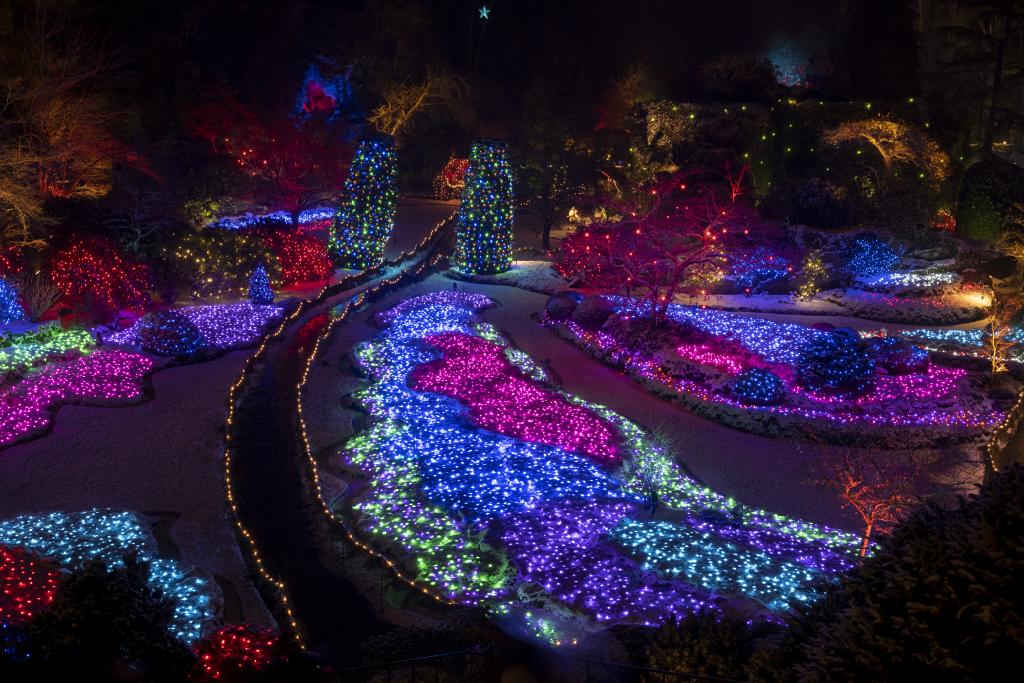 Snow added to the experience of the Magic of Christmas display this year
Snow added to the experience of the Magic of Christmas display this year
The prolonged periods of cold aren’t always a bad thing for the garden. When temperatures dip well below freezing the likelihood of mortality to garden pests increases. I’m optimistic that we reached low enough temperatures in December that we will hopefully see a positive impact on reducing some garden pests. Fortunately, beneficial insects, such as honey bees, which are already threatened by variety of issues including widespread infection by a parasitic mite, are not likely to be impacted by a cold winter. Bees hibernate in their hives for the winter and huddle together for warmth, emerging in the spring to resume their annual flower feast. We will be ready to welcome the bees when they decide to reemerge and feed on the many plants we grow to attract pollinators.
When the temperatures begin to dip many gardeners tend to put their gardens on hold and return when the warm weather returns in the spring. Depending on where you call home, gardening may not be an option during the cold winter months. Here at The Butchart Gardens staff are working feverishly to prepare for the upcoming season. The winter months are some of the most valuable months for us to complete projects, especially those which impact visitors. In order to keep this 110+ year old garden in pristine shape, we work proactively to restore some of the historic details of the garden that may be in need of repair.
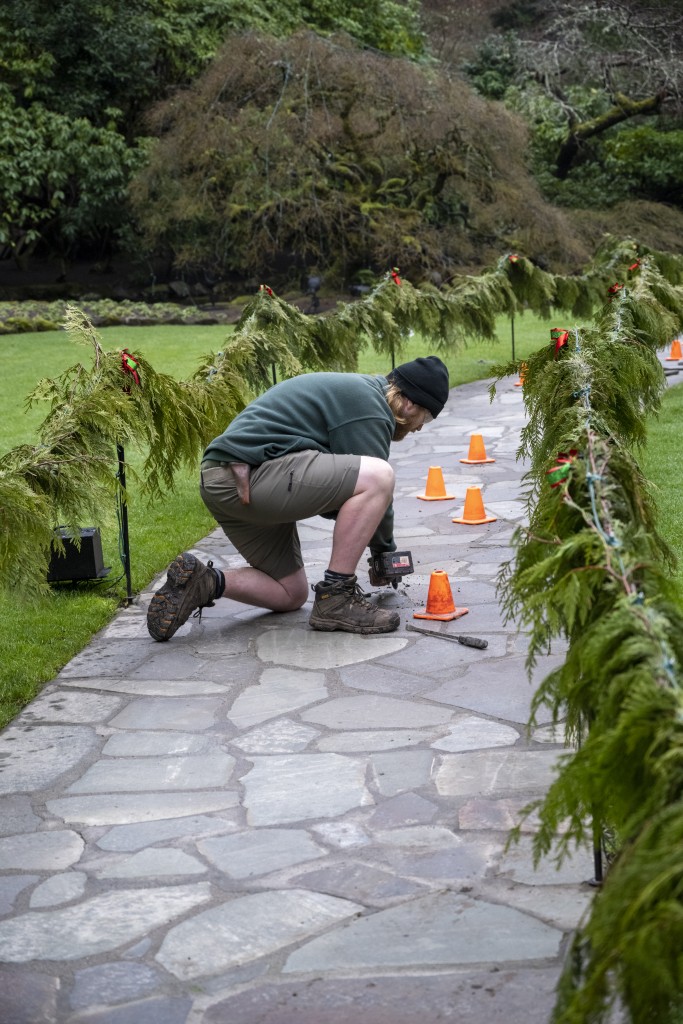 Pathway repairs in the Sunken Garden
Pathway repairs in the Sunken Garden
Behind the scenes our greenhouse staff is also preparing for the upcoming summer season. They are performing numerous tasks which include growing on cuttings, seed germination and tending to the thousands of plants that call our greenhouse home during the winter season. All non-hardy plant material grown outdoors in our summer floral displays are now being cared for in the greenhouses because it’s too cold for these plants to survive the winter outdoors.
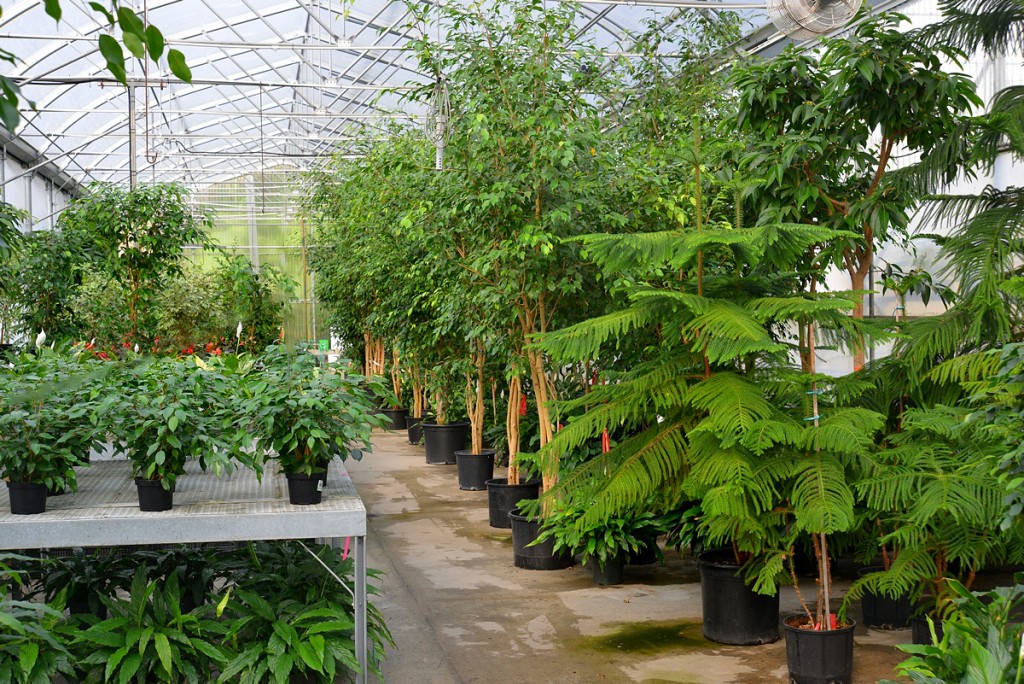 Inside one of the 26 greenhouses behind the scenes
Inside one of the 26 greenhouses behind the scenes
Aside from the enormous list of greenhouse responsibilities, one of the largest projects our gardens are involved with is the setup and take down of the indoor Spring Prelude. If you have never visited The Gardens between January 16 – March 19 and enjoyed the Spring Prelude, I encourage you to do so. The Spring Prelude is the ultimate hand-crafted indoor garden display, where our talented gardening staff transform The Blue Poppy Restaurant into a spectacular spring garden. It is here where you will be treated to an array of floral displays featuring tropicals and a vast collection of trees and shrubs. Many of the natural landscape pieces used in the Spring Prelude are sourced here at The Gardens in our native woodlands.
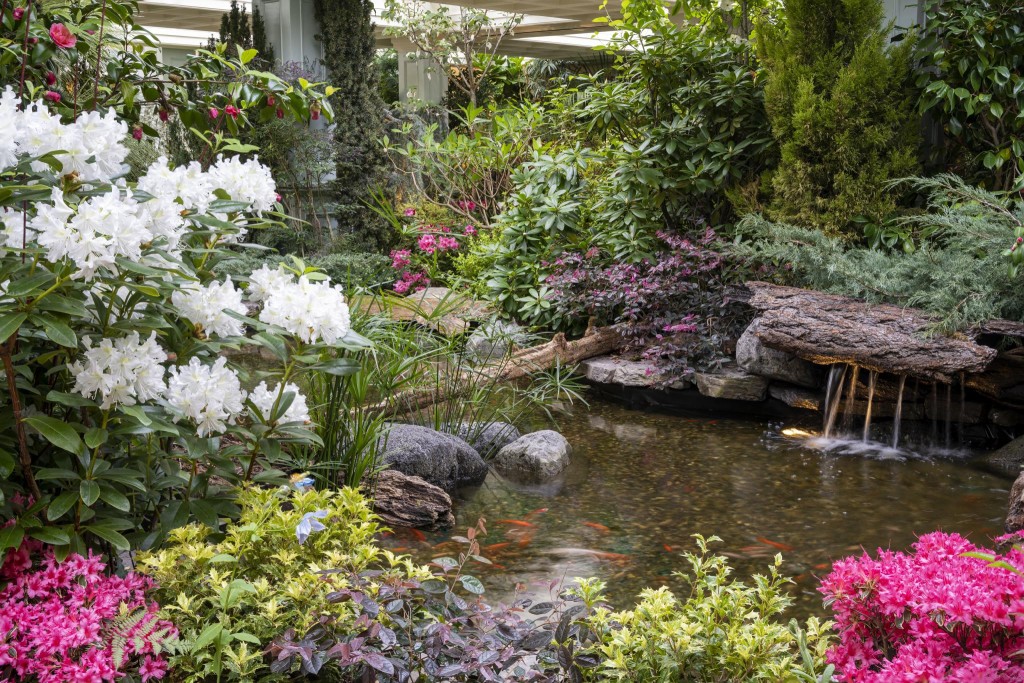 Last years Spring Prelude display
Last years Spring Prelude display
Taking a walk through The Gardens during the winter season is an incredible experience that will leave you feeling rejuvenated. Plants and the power of nature have their own unique way of providing humans a healthy environment to escape everyday life. It can be challenging to find the motivation to get outdoors during the winter; my hope is that reading this blog will provide you with motivation and encourage you to visit The Gardens. Our vast network of wheelchair friendly pathways offers everyone, including those with mobility challenges, a safe place to venture out and enjoy The Butchart Gardens.
We hope to see you soon!
Plants, trees and shrubs that are blooming or of interest
- Acer palmatum dissectum (Japanese maple)
- Aucuba japonica (Spotted laurel)
- Bellis (English daisy)
- Bergenia (Elephant’s ears)
- Camellia
- Correa (Australian fuchsia)
- Cotoneaster
- Cyclamen
- Erica (Heather)
- Galanthus (Snowdrop)
- Garrya elliptica (Silk- tassel bush)
- Hamamelis (Witch hazel)
- Helleborus (Christmas rose)
- Ilex verticillata (Winterberry)
- Jasminium nudiflorum (Winter jasmine)
- Mahonia x media ‘Charity’ (Oregon grape)
- Nandina domestica (Heavenly bamboo)
- Narcissus (Daffodil)
- Ophiopogon planiscapus (Black mondo grass)
- Pansy
- Pieris (Lily -of – the valley shrub)
- Polyanthus (Primula)
- Pyracantha
- Sarcococca (Christmas box)
- Skimmia japonica
- Viburnum x bodnantense
- Viburnum tinus
- Viola
Spring Prelude plants, trees and shrubs that are blooming or of interest
- Amaryllis
- Anthurium (Flamingo flower)
- Azalea
- Bromeliad
- Camellia
- Cercis
- Convallaria (Lily-of-the-valley)
- Crocus
- Cyclamen
- Daphne odora (Winter daphne)
- Edgeworthia chrysantha (Paper bush)
- Erica (Heather)
- Hamamelis (Witch hazel)
- Helleborus (Christmas rose)
- Iris reticulata
- Kalanchoe
- Loropetalum chinese ‘Razzleberri’
- Magnolia x soulangeana (Saucer magnolia)
- Narcissus (Daffodil)
- Ophiopogon planiscapus (Black mondo grass)
- Orchid
- Pachystachys lutea (Lollipop plant)
- Pieris (Lily -of – the valley shrub)
- Pinus
- Polyanthus (Primula)
- Prunus (Flowering plum)
- Sarcococca (Christmas box)
- Sciadopitys verticillate (Japanese umbrella pine)
- Skimmia japonica
- Stromanthe
- Tulipa (Tulip)
- Viburnum x bodnantense
- Viburnum tinus
- Viola

